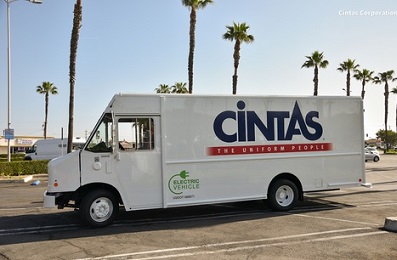CINCINNATI—Cintas Corp. recently launched its electric vehicle pilot program, which to date, includes almost 20 vehicles from multiple manufacturers.

Cintas operates one of the largest corporate fleets in North America with almost 14,000 commercial vehicles deployed throughout the United States and Canada, and it’s a significant source of the company’s Scope 1 (direct) greenhouse gas (GHG) emissions. Cintas acknowledges the importance of transitioning its fleet as it continues along its Path to Net Zero.
“Our ability to remove vehicles powered by fossil fuels from our fleet and introduce vehicles that run on renewable or alternative fuels will be an important factor in our ability to achieve our Net Zero ambition and reduce our carbon emissions intensity,” said Christy Nageleisen, Cintas Vice President of Environment, Social and Governance (ESG) and Chief Compliance Officer.
“When we meet with employee-partners in the field, the EV pilot program is always near the top of their interests. There’s a lot of excitement and anticipation throughout the organization about our EV program, and we’re eager to see how these pilot vehicles perform while out in service and running our routes,” Nageleisen added.
Hitting the Road
Cintas’ EV pilot program officially launched in early 2022 when the first vehicle was deployed in the Los Angeles area. To date, 17 different vehicles from five different manufacturers are or have been included in the pilot program with additional units in Cincinnati, Ohio; Detroit; Los Angeles, California; Minneapolis; San Francisco; San Jose, Calif.; and Seattle.
Evaluating EVs in Action
The pilot program will help Cintas evaluate the performance, durability, and reliability of various EVs in a variety of business, weather, and road conditions. Using the vehicles in real-world conditions is intended to help the company better understand the expectations, benefits, and potential challenges of EVs in its unique route-based business.
“When we originally decided to pilot the (electric) vehicles, we wanted to test markets that were cold, hot, that had snow—that had all the different weather conditions—so that we ensured we got the right vehicle for the right industry,” said Mark Bolen, Cintas Vice President of Quality and Engineering, whose group oversees the company’s fleet. “Up until this point, the technology wasn’t out there to start a program like this. Over the last two or three years, they’ve really come along to where the technology’s there.”
Cintas’ Fleet Department works closely with various original equipment manufacturers (OEMs) to identify additional opportunities, new technologies and future use cases that can maximize the effectiveness and performance of the EVs in the pilot program.
“We are constantly talking to our vendors, meeting weekly on conference calls, sharing information, then our team—the fleet team—actually has phone calls with our operations to understand exactly what’s transpiring throughout the week,” Bolen said. “We’re making sure the vehicle is performing where we want it to, and then we’re constantly making that range go out a little bit further, and a little bit further, a little bit further.”
What’s Ahead
As 2023 approaches, Cintas plans to procure and deploy additional EVs around its business footprint.
“We have a unique business, and our fleet has unique use cases, and we expect our fleet will continue to include different vehicle models, including various light-, medium-, and heavy-duty units to meet the needs of our business.” Bolen said. “As more options and technologies are developed, and more OEMs enter the commercial EV and alt-fuel markets, we expect to grow the pilot program in both quantity and scope.”
Additional grant funding has already been secured through different government initiatives and the company has plans to expand the current roster of EVs with as many as 50 additional units in the next calendar year. Cintas also plans to pursue additional opportunities to test and deploy new technologies from different manufacturers as they become available.
Cintas leaders are also monitoring innovations and developments in other types of alternate-fuel vehicles. Along with its ambition to achieve Net Zero GHG emissions by 2050, the commercial vehicle industry will also continue to evolve with new technologies and capabilities.
Bolen notes that Cintas remains open-minded about the types of vehicles the company will choose for its fleet over the long term, and that the company is anxious to evaluate new renewable and alternate-fuel vehicles when they’re available: “Who knows what the new technology will be in the next five, ten, fifteen years?”





